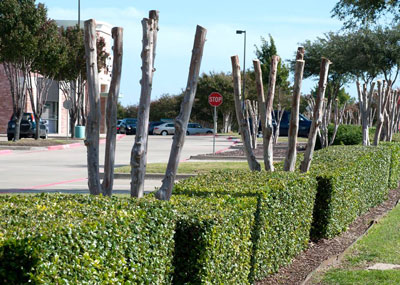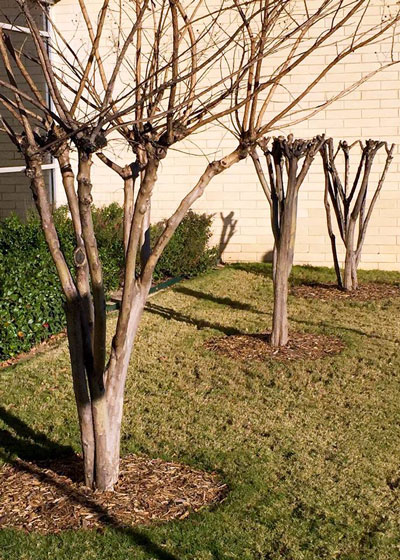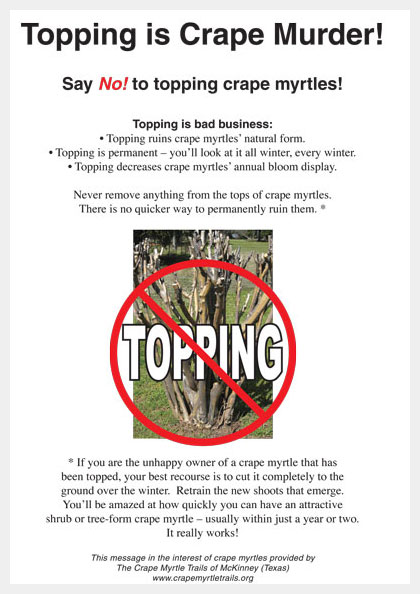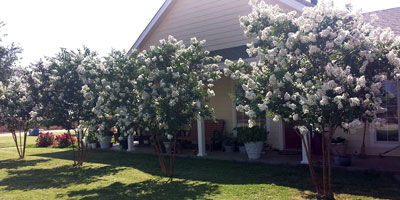Question of the Week Number 1: January 4, 2018

Photo: This is the worst case of topping I’ve ever seen. Along US 380 in Denton several years back.
“Neil, I get the message: ‘Topping crape myrtles ruins their shape and does nothing to help them.’ How can I help get that word out?”
I actually have had people ask me that intuitive question recently. It gives me great hope that a legion of common sense may be forming.

Photo: Commercial maintenance workers whack dozens of crape myrtles back in this Plano landscape each winter. I haven’t been by yet this year, but it appeared that they cut them lower each winter because I never saw the typical gnarls. (Eventually maybe they’ll get down to ground level and the poor plants will be able to get a fresh start on normal growth – see below.)
After watching this awful ritual happen for the past 50 years, I’ve come to the conclusion that my very own industry deserves a good bit of the blame. Commercial landscapers, looking for ways to keep their crews busy when they come back to work in early January, send them out with trucks, saws and shears and tell them to start topping. Soon, shopping malls, church grounds, schoolyards, retail storefronts and even city medians are being attacked.
So here’s my answer of what you can do…
That’s where consumers could be of the biggest help. Let the owners of those facilities know that topping ruins crape myrtles. Send them a link to this story. Here’s the url to copy and paste into your email: https://neilsperry.com/2018/01/question-week-number-1-january-4-2018/

Photo: The workers had to head home for the day before they finished their whacking. Poor plants!
Crazy claims used to support this barbaric pruning…
You’ll hear all kinds of excuses why people feel crape myrtles need to be topped. Here are the arguments I’ve been hearing for the past 50 years. All of them, by the way, are entirely bogus. I’ll follow with my comments.
• “I use topping to control their height.” But that doesn’t work. They grow right back where they were the next year. And in the meantime you’ve ruined their natural shape. If you have a crape myrtle that’s growing up into the eaves, you either need to move it (to a spot where it has more room) or remove it entirely.
• “It makes my crape myrtle bloom better.” If you’re talking about flowering six or eight weeks later than it would if you’d not pruned it at all, then you’re correct. If you’re talking about losing one or two additional rounds of blooms every summer because of that late first flowering, then again you’re correct. If you’re talking about giant flowerheads that are so heavy they cause the stems to arch over unnaturally and lay on the ground, then you’ve gone 3-for-3. But most of us don’t want any of those “benefits.”
• “I top my crape myrtles because everybody else does.” That one doesn’t deserve a reply.

How can I restore a topped crape myrtle?
For many years I thought there might be some way to prune and retrain the plants gently so they would eventually look normal again, but then I saw professionally pruned crape myrtles that had been topped back in the 70s and that still showed the telltale angular branching after 40 years of corrective reshaping.
That’s when I asked David and Mark Byers of Byers Wholesale Nursery (now closed) in northern Alabama. They were among America’s preeminent sources of crape myrtle plants and information. They gave me the simple solution…
• Cut the topped crape myrtle completely to the ground. That gets rid of all the old evidence.
• The first year you’ll have several dozen new shoots sprouting up from the roots. Let them all grow for spring and most of the summer.
• By August of the first year, select the 8-10 strongest shoots and remove all the rest.
• Sometime the second growing season, thin the number of trunks down to 5-7. You want to leave extras at each of these early steps in case any becomes broken or damaged.
• By the second winter you can choose the final 3 to 5 trunks. As the tree grows taller you’ll be able to remove side branches and train it tree-form.
• You’ll have a beautiful tree-form crape myrtle within a couple of years this way – without any of the telltale scars of its past.

Photo: Facebook friend Renee D. posted this photo of her lovely Natchez crape myrtles last June showing how well they had come back after being cut back to the ground as just described. Folks, it does work!
